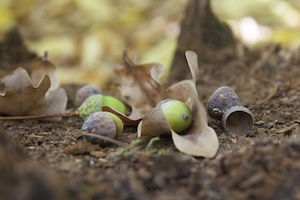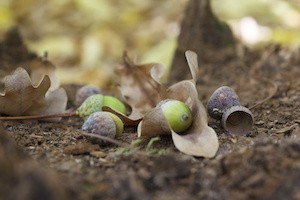Recently I started one of these columns under the slug “Acorns”, the ‘slug’ being the name-tag all journalists use to identify their individual stories.
At the time it had been my firm intention to write a piece about acorns and the fact that roadways, driveways, footpaths and parklands were currently being littered by acorns in their millions, especially around the Waikato where oaks seem to grow in great profusion.
But somehow I got sidetracked on to recollections of the aromas from our farmhouse kitchen in my youthful days on the Otewa dairy farm at the back of Otorohanga.
This time I’m definitely sticking with acorns and oak trees. In the right places they are, indeed, a magnificent, beautiful, spectacular tree, and there are certainly some superb groves and individual specimens scattered throughout the wider Waikato. Matamata and its surrounding farmland has some marvellous lines and avenues and copses of old-man oaks, and there are similar growings around Hamilton, Morrinsville, Cambridge and Te Awamutu.
On the sloping parklands of the north-eastern side of Lake Rotoroa, in central Hamilton, there are a number of great, towering oaks that may be a century old, and there’s a small grove on State Highway 3 a little north of Te Awamutu which may be of a similar age. These latter trees seem to be taking something of a hammering of recent times, with great boughs snapped or wrenched off, leaving ugly jagged branch stumps staring mutely out through the broad green surrounding blanket.
But it’s the massive amounts of acorns that were produced last autumn – an apparent wide-spread mast season for many trees, both native and exotic – that have made such an impression, some of them probably a little painful. Try riding a pushbike under an old-man oak while there’s a bit of a breeze running, and you could find yourself not just trying to dodge a hail of hefty nuts but also endeavouring to steer across what can sometimes be a carpet of marbles spread across the road. It would undoubtedly be far worse if you were travelling at speed on a motorbike and had no face visor.
We were driving out of Leamington on a Saturday morning when the forerunners of Cyclone Lusi began stamping their way across the Waikato, flapping the region with a high-powered breeze and spreading a meagre smattering rain. The rain amounted to a pathetic raspberry for Waikato farmers desperate for a good, steady deluge, but the wind made itself felt a little more extensively – especially to us as we drove under those huge oaks that line the southern side of the Cambridge – Te Awamutu road as it leaves Leamington.
They sounded like gunshots, and several of us winced and ducked instinctively as three or four big fat acorns, shaken loose by the wind, slammed into our windscreen. Had they been a little harder, or had we been going faster, they may well have cracked the glass.
Mind you, acorns can certainly sting, as many a young country lad can testify. Fifty years ago and more shanghais were a standard piece of the militaristic accoutrements carried by lots of tearaway pre-teen boys, and they were used regularly and often. Small round river stones were the best ammunition, and if hit squarely even a pukeko or rabbit could be successfully rolled at 25 metres with a good shanghai shot. But they took a good deal of hunting out, those rounded little stones, and small boys wandering along roads with their eyes glued to the loose gravel piled in neat rows between the tyre-tracks were a common sight. It was long before the days of tar-seal. The power and telephone-line cups on the high hardwood cross-beams that also followed the country roads were inevitably a good target, and only acute embarrassment as an adult prevents me now from admitting how many of those cups I partially shattered in one good day along the Otewa farm’s mile of road frontage. I was maybe 11 years old at the time.
But you needed good rubber in those shanghais, and car tyre tubing was best, although double strips of bicycle tube were almost as good. And the design was either the single strap style or the safer design using a Y-shaped piece of manuka. The single strap system sometimes resulted in a badly-hammered thumb nail on the leading hand as the released stone slammed into it on the way forward.
In the acorn season the fat brown nuts made ideal second-grade ammo – perhaps good for shanghai fights in the school-ground, but not so good for more serious small game hunting. Mind you, even with best-quality river stones, the chances of a winning hit on a rabbit or ‘pook’ were slim, at very best. But it was the ‘thrill of the chase’ that was the thing when we were young and expectations were endlessly high. In the playground, a high-speed acorn on the leg at 10 metres induced either total rage or copious tears. Often revenge was sweet – as a nut.
We kids also collected acorns by the thousands when the main nut-fall was on, one or other of us climbing high into the oak and them sidling perilously out into the branch-ends which were then shaken as vigorously as a skinny little boy can. Inevitably, this resulted in a blistering hail of nuts raining down onto the ground, and we would all scrabble through the leaf-litter and grass, pouring handsful of acorns into tins and the filled tins into buckets. Dad would empty the buckets into a 44-gallon drum up at the piggeries, and in the cold months of our King Country winter he would scatter daily sparing tins of acorns into the troughs of the ‘stores’ – the young and growing pigs on their way to becoming porkers or, closer to Christmas, baconers, which were really being beefed up to provide festive season hams. The nuts would last for weeks.
The pigs loved those acorns, and we delighted in hearing them crunch down hard on the nuts as they bustled and scruffled in the depths of the troughs for the last remaining tidbits. Their crunching sounded just like biting into a Gingernut biscuit – one of the few commercial cookies we had on the farm.
Years ago, one of Hamilton’s leading magistrates, Mr Brian Mooney, gave me a slim folder of remarkable little stories this absolute gentleman had accumulated over a lifetime of observation and interest in the world around him. One of those stories involved acorns, and an ancient shepherd who worked almost unnoticed in the mountains of somewhere like Spain or France in the early part of the twentieth century.
In the autumn each year, when he brought his flock down from the high mountain pastures, he would pass through great oak woods as he came to villages in the valleys. And in the woods, as he slowly fed his flock along each day, he collected fallen acorns, putting them into the great pockets of his voluminous robe. At night, with his flock safely bedded down and himself fed, he sorted his acorns, keeping only the good, whole, uncracked ones. It was a task that occupied much of his winter evenings, but by the spring, when he was ready to take his sheep back to the high meadows, his acorns were ready. He had thousands.
And when he got to the great wide open spaces on the upper mountainsides, he started planting, jabbing the point of his shepherd’s crook into the ground far enough to bury a single acorn and then treading carefully on the hole to cover it up and give the nut a good chance at germination before being discovered by a hungry rat or squirrel. He did this for years, quietly, unobtrusively, without telling a soul. He planted hundreds of thousands over several decades. Of course, not all of them sprouted, but a great many did, and as the new trees grew and spread, scientists and other learned people pondered long and deep on the remarkable phenomenon – how could these magnificent young forests have possibly germinated and flourished?
I can’t remember the end of the story, or how the old shepherd’s secret was discovered, and I guess he wouldn’t have worried one way or another. But what a magnificent legacy to have left a nation.
I wonder what New Zealand would look like in 50 years from now if public areas were made available and a tree for every person in the nation was planted every year – 4½ million this year, 4½ million next year; five million by 2020; six million by 2040 … They could be colour trees, flowering natives for birds, trees for wood – firewood for those who need it, timber for building; picture trees, trees to hold the land together, trees to shade livestock or protect fishlife in waterways or give food and shelter to our enormous and still not-fully recorded insect and invertebrate life.
My Dad planted maybe 20,000 trees in his lifetime, and I helped him sometimes. There are many others who have planted lots more than he. They’ve made a good start – you’ll see those plantings scattered densely all over the Waikato basin and elsewhere. And standing proudly in among them I’m sure you’ll see some good old English oaks.
I’ve often wondered who those early visionary planters were.
By Kingsley Field. Read more here.
Kingsley Field is an author and journalist. He has published two illustrated volumes of these columns and is now working on Volume III. They are available at kingsley@accuwrite.co.nz











Join the Discussion
Type out your comment here:
You must be logged in to post a comment.